Ken's Fishing Tips
After his many years of fishing and guiding on these lakes, in and around El Dorado County, California
Union Valley Reservoir, CA
Ice House Reservoir, CA
Loon Lake Reservoir, CA
Bear River Reservoir, CA
And also...
Pyramid Lake, NV
Flaming Gorge, Utah
Ken is sharing his trolling tips that have been proven thru the years in helping us not only to design tackle that works and produces fish.
Trolling is an easy and successful way to catch trout. first you must select the way you are going to troll, be it down rigging or top lining. There are many different types of flasher and lure combinations that can be used. Trolling flashers trailed by a lure, such as a trolling flutter spoon or spinner. A dodger trailed by a lure such as a hoochie, flutter spoon or spinner. Or trolling just a lure by itself, such as our Double Flutter Lure, our Trolling/Casting spoons, or Trolling Flutter Spoons can be productive.
Trolling flasher or dodger selection is critical. It is going to be made according to conditions, such as water clarity and weather conditions.
Selection for weather condition: On clear to partly cloudy days, use gold and silver bade combinations or nickel dodger. Overcast days or low light conditions such as early evening, used our polished copper or brass dodgers or a glow dodger (be it painted glow or has glow tape such as our Code Blue Glow or Crush Glow. Down Rigging requires maximum flash and vibration.
Basic Dodger Set-up: Dodger is attached to your main line with a snap swivel. If you are using a lure with no action, such as a trolling hoochie, you want to attach the lure behind the dodger with a line that is 1 1/2 times the dodger length. If you are using a lure with action such as a spinner, trolling flutter spoon or Double Flutter Lure, you can attach the lure behind the dodger with a line that is up to 3 times the dodger length.
Basic Flasher Set-up: Attach flasher to main line with a snap swivel. From the end of the flasher attach your lure approx. 12-24 inches behind the flasher.
Top Lining Basics: Let the dodger or flasher and lure trail beside the boat and check for action of blades and lure. Adjust speed of the boat for maximum flasher and lure performance. The tip of the rod should pulsate with correct flasher action. Start releasing line until flasher set up is approx. 75-125 feet behind the boat. We find more fish striking in approx. 75-100 feet. When your set up is running behind the boat in this range your flasher and lure are generally running at approx. 8-25 feet deep depending on the size and weight of your set up. The larger (heavier) set up will run deeper. Troll in gentle s-curves, lures on inside of curve will slow and sink, lures on outside will speed up and rise, triggering fish to strike. Fish are not likely to strike if lure runs at a constant speed. Ken finds that occasionally an increase or decrease in speed also helps to trigger strikes.
Down Rigging Basics: Troll in old river channels or next to drop offs. Ken finds it best on some lakes to down rig next to steep banks in 40-60 feet of water, but will also adventure into deep channels and around bottom structures, which also hold fish. Also if you can find bait balls in the water, run your down rigger so that your lure is running just under the bait ball.
In late spring, the larger lakes will separate into 3 temperature layers, with the middle layer being the thermocline, which is generally the most productive temperature zone. You should troll close to or in this layer, which is generally from 15-50 feet deep.
Some of the best areas to troll are around the inlets or outlets, rocky banks and steep drop offs.
In windy conditions, troll close to shore where food is being blown. Fish will generally hold in 8-25 feet, close to the food source.
Remember, these are only suggestions based on Ken's experience and years of fishing. Every trip is different and everyone has a different way of fishing. These are just some of the tips that work best for us. The rest is up to you. Just have fun!
Ken's Favorites for...
Kokanee
If using flashers, our medium Curved Blade "Kokanee" Special have worked about the best for us. Attach any one of our spinners in pink, chartreuse or color of your choice, to the back of the flashers. Ken likes to tip the hooks with white corn that has been dyed and soaked in scent oil. (see corn tips below)
If using a dodger, any of our nickel, copper or brass dodgers with Blue Prism, Crush Glow or Code Blue Tape works great. Attach one of our trolling hoochies or spinners behind the dodger and again tip the hooks with white corn.
Trolling speed should be 1 to 1.7 mph.
Down rigging for kokanee is done by using one of our ball flashers attached to the down rigger weight. You can then attach your dodger/lure or flasher/lure combo into a stacker clip about 3 ft. above the down rigger weight, with enough line out so that the lures are running approx. 3-6 ft. behind the ball flashers that are attached to the ball.
Note: Dodger Set Up. Lures with no action, hoochies, bugs or flies, attach approx. 1-3 dodger lengths behind the dodger. Lures with action, spinners, flutter spoons, apex etc. can be attached 3-6 dodger lengths behind the dodger.
Corn Tips for Kokanee:
For Pink Dyed Corn, use white shoe peg corn. Leave in can with juice and add 1/2 to 1 tsp. Pro cure's Wizard Kokanee Killer Korn Dye. Let soak 30 mins. Drain off all juice. Transfer to storage container and add 1/2 to 1 oz. of your favorite scent oil, either Pro Cure's Anise, Fresh water shrimp, Predator liquid or Kokanee Special. Ken's favorites are Carp Spit, Garlic/Anise combo, Kokanee Special, Krill or Freshwater Shrimp.
For just white shoe peg corn we like to soak it in plain vanilla, or any of the Pro Cure bait oils listed above for kokanee.
Keep track of what works best for you at each lake. In some lakes the kokes will like one scent or color better than another.
I/2 of a mini night crawler also works well, sometimes. Some of Ken's other favorites for kokanee are Berkley Power Maggots, in pink or chartreuse. These are great to use at Flaming Gorge where you can't use corn!
For Rainbow Trout:
Any of our willow leaf or curved blade flashers trailed by one of our Trout Series Spinners or one of our trolling flutter spoons tipped with 1/2 a night crawler is our favorite for the rainbows. Another favorite is our Watermelon dodger with one of our melon spinners.
For Brown Trout:
Our Double Flutter Lure in Fire Tiger, Rainbow or any of the other colors, trolled by itself works great for the Browns. Our 3 inch trolling flutter spoons also work great. Troll speed should 1-2 mph.
For Mackinaw:
Any of our Double Flutter lures trolled by itself, or behind one of our dodgers, is what works best for us. Ken's favorite way to fish the Double Flutter Lure is to coat the lure with Pro Cure's Herring or Krill Gel Scent. Let out the lure to approx. 100-200 ft. then attach to your down rigger. Run the ball down so that you are working under the schools of kokanee or bait fish. If they are holding in 60' of water, run down rigger down at 70-80 ft. or split depth of bottom to bottom of bait fish ball. Macks and Browns feed near these schools and this works best. If no bait fish can be found, work 10 20 ft. off bottom around heavy structure.
Another way that has been working great for us is using one of our larger Mackinaw Dodger/Hoochie Pro Pack, which includes a larger dodger, on of our Krilledible salmon hoochies and a treble hook pre-tied ready to go. Thread the leader, using a bait threader, thru the anus and out of the mouth of a frozen herring. Pull leader thru until the eye of the treble hook is tucked inside of the herring. Thread leader thru the hoochie and slide the hoochie down over the herring so that the herring is now covered by the hoochie. Now attach the leader to the snap swivel on the dodger. Leader length should be 2-3 dodger lengths.
Best speeds 0.9 mph to 1.4 mph. I also like to us Pro Cure Herring Gel on the dodger and hoochie/herring.
The larger dodger/hoochie combo works best with a 6" frozen herring. The medium dodger/hoochie combo works best with a 4" frozen herring.
Pyramid Lake Cutthroat:
Pyramid Lake Cutthroat can be caught from shore, casting lures or fly fishing, or from a boat, either trolling or jigging. Either way can be a lot of fun!
From a boat...
Trolling: When top lining you want to run your lure 75-125 ft. behind the boat. And your lure should be running in the top 15-30 ft. of water. This is great for working shallow water or in wither conditions.
If you are having a hard time getting your lure down deeper without a down rigger try using a 2 oz. banana weight approx. 30" in front of your lure.
Down Rigging. Cutthroat are not shy of the weight. Sometimes they are attracted by it so try a 75 ft. set back on one down rigger and 15-25 ft. set back on the other and see what works best. If you see fish on the finder darting to the down rigger weight then a short set back is best. Try to locate bait balls or structure which are holding fish. While working the bait balls use minnow pattern lures like our Double Flutter Lure, Trolling Flutter Spoon or one of our Trolling/Casting spoons. The Double Flutters have been working the best because of their vibration and crippled fish like action. Work just below the bait and target the large arcs on the finder. Vary your speed If you are trolling structure, work 10-20 ft. off bottom. Sometimes while using a short set back about 15-25 ft. I will lower the down rigger ball to hit bottom and then raise it back up to trigger a strike. This is deadly for the trophy fish.
Dodger Lure Set up. Ken likes to use our larger Golden Glow Tiger Dodger or one of our Mackinaw dodgers with a flutter spoon. Tie the flutter spoon 3-5 dodger lengths behind the dodger. Using the larger dodgers will sometimes bring more fish in to your lure. How ever, if you have any fish strike the dodger its self, switch up to a larger lure with no dodger, such as our Double Flutter Lure.
Sometimes we find that size does matter. If a large lure like the Double Flutter is not working, try a smaller lure such as our 3" Trolling Flutter Spoon or one of our Trolling/Casting spoons by its self.
Again best boat speed 1.2 to 1.7 mph. But you must vary your bat speed or use s-turns to make the lure rise and fall. One technique I have used is too put the boat in neutral for a couple of seconds then back into gear, hopefully causing the fish to strike.
Jigging: After finding structure or bait balls that are holding fish, use a 1-3 oz. jig over this area. Work jig on bottom up to 10 ft. up with a jigging motion. We find that glow or minnow pattern jigs work best.
Shore Fishing...
There are a couple of different approaches to shore fishing. Some people will just wade out about 20 ft., while there are others that will use fishing ladders (or a regular household ladder) placed about 20 ft. out, to sit on.
Casting spoons is an excellent way to catch Pyramid Lake Cutthroats. Cast lure and let it sink to bottom them retrieve with an erratic motion. Fast & slow or even little jerks on the rod while reeling in. Sometimes the fish will follow and strike at waters edge. On dark or cloudy days we like to use glow patterns or dark patterns. On sunny days nickel, gold and bright colors work great. We have a great line of Trolling/Casting spoons that have all been proven to catch fish at Pyramid Lake.
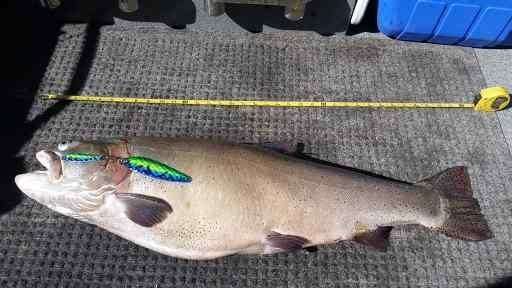
Pyramid Lake Cutthroat caught with our Blue Tiger Double Flutter.
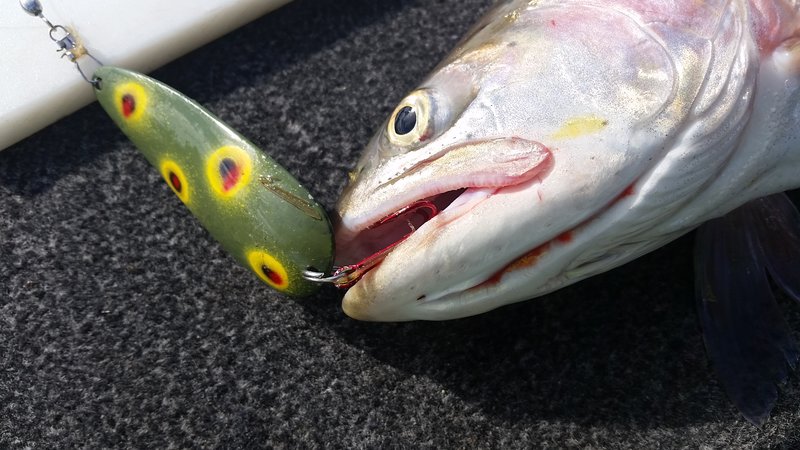
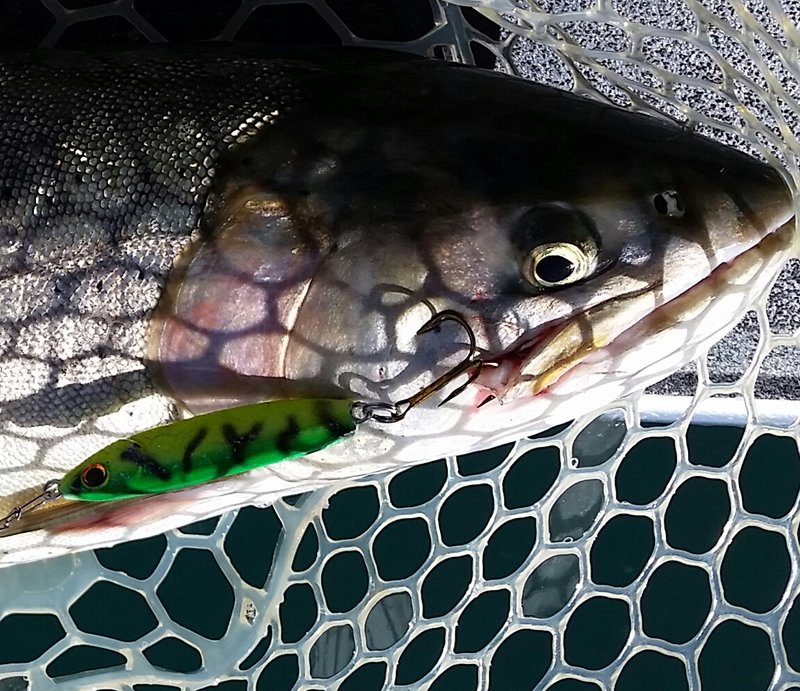
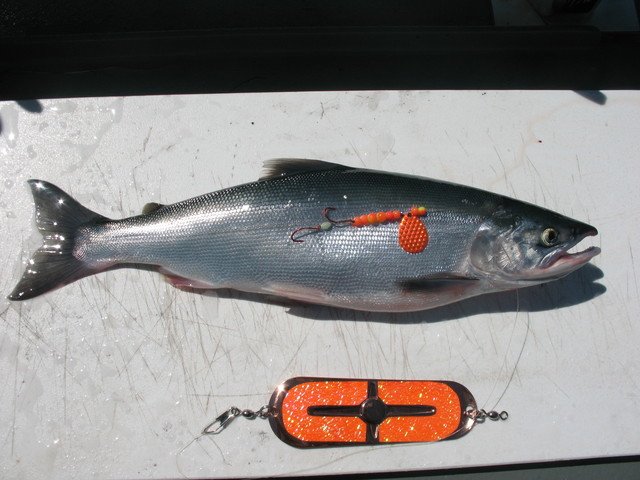
Kokanee caught using our Orange Crush Dodger and an Orange Diamond Spinner.
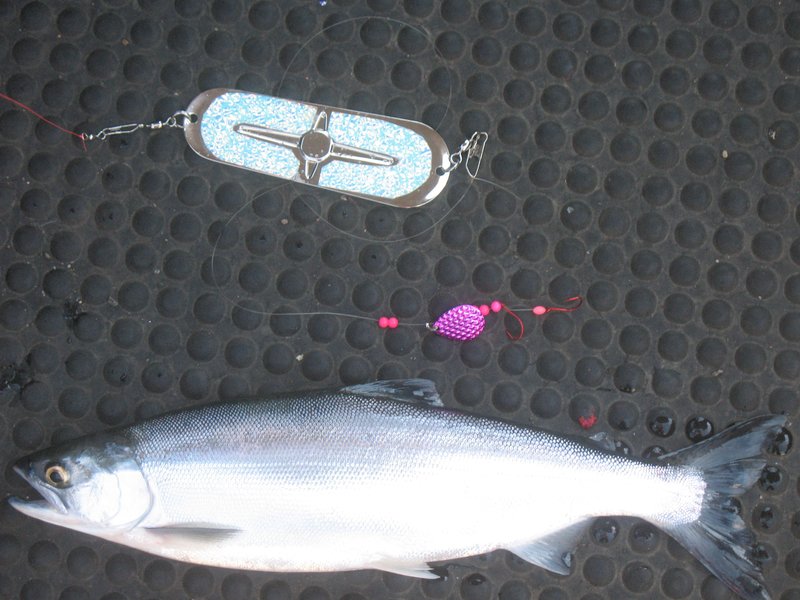
Kokanee caught with our Code Blue Dodger and a Purple Diamond Spinner. This is one of Ken's favorite set ups for the kokanee.